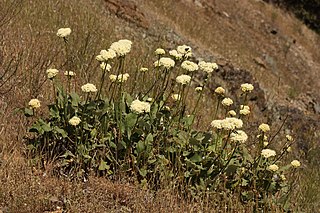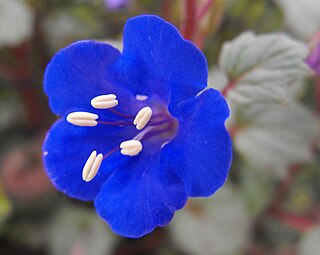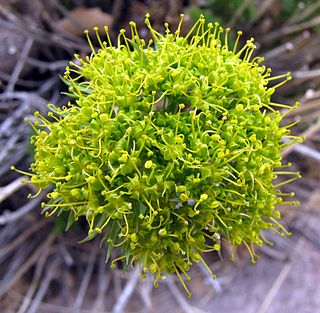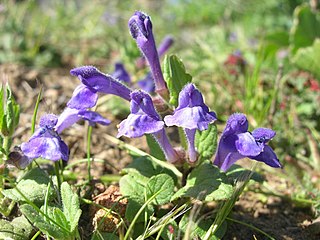
Eriogonum is a genus of flowering plants in the family Polygonaceae. The genus is found in North America and is known as wild buckwheat. This is a highly species-rich genus, and indications are that active speciation is continuing. It includes some common wildflowers such as the California buckwheat.

Phacelia campanularia is a species of flowering plant in the borage family, Boraginaceae, known by the common names desertbells, desert bluebells, California-bluebell, desert scorpionweed, and desert Canterbury bells. Its true native range is within the borders of California, in the Mojave and Sonoran Deserts, but it is commonly cultivated as an ornamental plant and it can be found growing elsewhere as an introduced species.

Petalonyx is a small genus of flowering plants native to the southwestern United States and northern Mexico. They are known commonly as sandpaper plants, and are most often found in warm, dry desert regions. Sandpaper plants are subshrubs that get their common name from their rough foliage, which is covered in tiny, stiffly curved hairs. They bear racemes of claw-shaped flowers with long stamens extending well beyond the corolla, and unusual in that they emerge from outside the corolla.

Eremothera boothii is a species of wildflower known as Booth's evening primrose. This plant is native to the western United States and northwestern Mexico where it is most abundant in arid areas such as deserts. This is an annual plant with hairy reddish-green stems and mottled foliage. The stem ends in a nodding inflorescence of many small flowers which may be white to red or yellowish, often with darker shades on the external surfaces of the four spoon-shaped petals. They have long stamens with clublike yellowish anthers. Flowers of this species tend to open at dusk rather than dawn as in many other Camissonia. The fruit is a twisted capsule one to 3 centimeters long. Plant appearances may vary across subspecies.

Clarkia gracilis is a species of wildflower known by the common name slender clarkia. This plant is native to the US states of California, Oregon, and Washington, where it is found in coastal, foothill, valley, and low-elevation mountain habitats. The plant is variable across subspecies but is generally an erect slender stem with a few sparse, narrow leaves several centimeters long. It bears an inflorescence of drooping buds which open into bowl-shaped flowers with pinkish lavender petals 1 to 4 centimeters long and bearing a red or white splotch which can appear in the center or at the base of the petal, depending on the subspecies.

Clarkia purpurea is a species of wildflower known by the common names winecup clarkia, winecup fairyfan, and purple clarkia.

Cymopterus gilmanii is a species of flowering plant in the carrot family known by the common name Gilman's springparsley.
Astragalus gilmanii is a species of milkvetch known by the common name Gilman's milkvetch. It is native to the desert scrub and woodland of Nevada, the California Sierra Nevada and Inyo Mountains, and it is known from a few locations in the Panamint Range adjacent to Death Valley in California.

Lomatium parryi, commonly known as Parry's biscuitroot and Utah desertparsley, is a perennial herb in the carrot family. It is a common herb in high altitude areas of deserts and common in desert National parks, such as Death Valley mountains, in the western part of the United States.

Mentzelia montana, known by the common name variegated bract blazingstar, is a species of flowering plant in the family Loasaceae.

Mentzelia tricuspis is a species of flowering plant in the family Loasaceae known by the common name spinyhair blazingstar.
Navarretia prolifera is a species of flowering plant in the phlox family known by the common names bur pincushionplant and yellow bur navarretia. It is endemic to the Sierra Nevada foothills of California, where it grows near running water.

Oenothera californica, known by the common name California evening primrose, is a species of flowering plant in the evening primrose family.

Penstemon fruticiformis is a species of penstemon known by the common name Death Valley beardtongue. It is native to the western United States, where it is found growing in rocky scrub, woodlands, deserts and mountains of eastern California and western Nevada. It is known from scattered occurrences around Death Valley, and only one of the two varieties occurs on the Nevada side of the border. It is a perennial herb producing spreading, multibranched, hairless and waxy stems 30 to 60 centimeters tall. The thick leaves are generally lance-shaped, folded and rolled, and up to 6.5 centimeters in length. The inflorescence produces several white or pale pinkish-lavender flowers between 2 and 3 centimeters long. The mouth of the flower bears a stark, dark line on each of its three lower lobes, nectar guides for its pollinators which probably include native bumble bees.
Petalonyx linearis is a species of flowering plant in the family Loasaceae known by the common name narrowleaf sandpaper plant. It is native to the deserts of eastern California, western Arizona and northwestern Mexico, where it grows in scrub and other habitat. It is a rounded clumpy subshrub made up of many rough-haired, erect stems up to a meter tall.

Petalonyx nitidus is a species of flowering plant in the family Loasaceae known by the common name shinyleaf sandpaper plant. It is native to the deserts and desert mountains of the southwestern United States, where it grows in scrub, woodland, and other habitat. It is a clumpy subshrub made up of many rough-haired, erect or spreading stems growing 15 to 45 centimeters long. The leaves are oval, pointed, usually toothed or serrated, and up to 4 centimeters long. The inflorescence at the end of the stem is a crowded raceme of many flowers. The flower appears tubular, its white petals fused near the spreading tips but open lower, the long stamens extending well beyond the corolla, and unusual in that they emerge from outside the corolla.

Scutellaria tuberosa is a species of flowering plant in the mint family known by the common name Danny's skullcap. It is native to western North America from Oregon through California to Baja California, where it is widespread throughout the mountain and coastal regions; it is absent from the deserts and the Central Valley of California. It can be found in forest and woodland habitat, and a variety of open habitat types, often appearing in areas recently cleared by wildfire. It is a perennial herb producing an erect stem or cluster of stems up to about 25 centimeters tall from a root system with tubers. The stems are coated in short, spreading hairs. The oval leaves are oppositely arranged. The lowest leaves are borne on short petioles. Flowers emerge from the leaf axils. Each flower is held in a calyx of sepals with a large ridge or dome-shaped appendage on the upper part. The tubular corolla is one to two centimeters long and has a large upper and lower lip. The upper lip is folded into a beaklike protrusion and the lower has three wide lobes. The corolla is deep purple-blue, usually with a white patch or mottling on the lower lip.

Thelypodium integrifolium is a species of flowering plant in the mustard family known by the common names entireleaved thelypody and foxtail thelypodium. It is native to much of the western United States, including the Great Basin and surrounding plateaus and deserts.

Trifolium eriocephalum is a species of clover known by the common name woollyhead clover or hairy head clover.

















